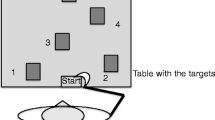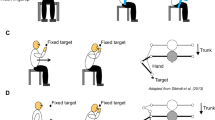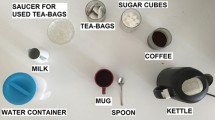Abstract
Slow movements and atypical patterns of muscle activation are well-known features of Down Syndrome (DS). Some studies attribute these features to a deficit in voluntary motor commands and preprogramming of actions, that lead subjects with DS to be more reliant on feedback control. In the present study, we evaluated the movement strategies of 13 adult subjects with DS and of 22 age-matched controls (N) during an arm tapping task. By means of quantitative motion analysis, our aim was to describe movement differences in DS respect to typical population and provide a means of interpreting such differences in terms of the underlying different control processes. The results highlighted distinct motor strategies for the tapping task in the two groups, with DS relying more on the trunk motion and N relying on the elbow motion to accomplish the task. Furthermore, DS corrected their wrist trajectory more than N subjects, giving shape to multi-peaked velocity profiles. Longer duration of the trials and a higher index of curvature were found in DS. The results suggest that subjects with DS rely more on feedback control, whereas they have problems with movement planning and feed-forward control. The different strategy operated by subjects with DS leads to a different task performance.




Similar content being viewed by others
References
Almeida GL, Corcos DM, Latash ML (1994) Practice and transfer effects during fast single-joint elbow movements in individuals with Down syndrome. Phys Ther 74(11):1000–1012
Anson JG (1989) Down syndrome: neuromotor programming and fractionated reaction time. In: Latash ML (ed) Motor control in Down syndrome. Chicago, Ill, Latash, pp 6–11
Anson JG, Mawston GA (2000) Down syndrome: patterns of muscle activation in simple reaction time tasks. In: Weeks DJ, Chua R, Elliott D (eds) Perceptual-motor behaviour in Down syndrome, 3rd edn. Human Kinetics, Champaign, IL, pp 3–24
Aruin AS, Almeida GL, Latash ML (1996) Organization of a simple two-joint synergy in individuals with Down syndrome. Am J Ment Retard 101(3):256–268
Boone DC, Azen SP (1979) Normal range of motion of joints in male subjects. J Bone Jt Surg Am 61(5):756–759
Charlton JL, Ihsen E, Oxley J (1996) Kinematic characteristics of reaching in children with Down syndrome. Hum Mov Sci 15(5):727–743
Cole KJ, Abbs JH, Turner GS (1988) Deficits in the production of grip forces in Down syndrome. Dev Med Child Neurol 30(6):752–758
Davis WE, Kelso JA (1982) Analysis of “invariant characteristics” in the motor control of down’s syndrome and normal subjects. J Mot Behav 14(3):194–212
Elliott D, Hansen S, Grierson LE, Lyons J, Bennett SJ, Hayes SJ (2010) Goal-directed aiming: two components but multiple processes. Psychol Bull 136(6):1023–1044
Frith U, Frith CD (1974) Specific motor disabilities in Down’s syndrome. J Child Psychol Psych 15(4):293–301
Galli M, Rigoldi C, Brunner R, Virji-Babul N, Albertini G (2008) Joint stiffness and gait pattern evaluation in children with Down syndrome. Gait Posture 28(3):502–506
Galli M, Cimolin V, Patti P, Ferrario D, Heaney G, Albertini G, Freedland R (2010) Quantifying established clinical assessment measures using 3D-movement analysis in individuals with Down syndrome. Disabil Rehabil 32(21):1768–1774
Karst GM, Hasan Z (1991) Timing and magnitude of electromyographic activity for two-joint arm movements in different directions. J Neurophysiol 66(5):1594–1604
Kerr R, Blais C (1987) Down syndrome and extended practice of a complex motor task. Am J Ment Def 91(6):591–597
Latash ML (1992) Motor control in Down syndrome: the role of adaptation and practice. J Dev Phys Disabil 4:227–261
Latash ML, Corcos DM (1991) Kinematic and electromyographic characteristics of single-joint movements of individuals with Down syndrome. Am J Ment Retard 96(2):189–201
Latash ML, Almeida GL, Corcos DM (1993) Preprogrammed reactions in individuals with Down syndrome: the effects of instruction and predictability of the perturbation. Arch Phys Med Rehabil 74(4):391–399
Menegoni F, Milano E, Trotti C, Galli M, Bigoni M, Baudo S, Mauro A (2009) Quantitative evaluation of functional limitation of upper limb movements in subjects affected by ataxia. Eur J Neurol 16(2):232–239
Morris AF, Vaughan SE, Vaccaro P (1982) Measurements of neuromuscular tone and strength in Down’s syndrome children. J Ment Defic Res 26(1):41–46
Petuskey K, Bagley A, Abdala E, James MA, Rab G (2007) Upper extremity kinematics during functional activities: three-dimensional studies in a normal pediatric population. Gait Posture 25:573–579
Rigoldi C, Galli M, Albertini G (2011a) Gait development during lifespan in subjects with Down syndrome. Res Dev Disabil 32(1):158–163
Rigoldi C, Galli M, Mainardi L, Crivellini M, Albertini G (2011b) Postural control in children, teenagers and adults with Down syndrome. Res Dev Disabil 32(1):170–175
Rigoldi C, Molteni E, Rozbaczylo C, Morante M, Albertini G, Bianchi AM, Galli M (2012) Movement analysis and EEG recordings in children with hemiplegic cerebral palsy. Exp Brain Res. doi:10.1007/s00221-012-3278-2
Shumway-Cook A, Woollacott MH (1985) Dynamics of postural control in the child with Down syndrome. Phys Ther 65(9):1315–1322
van der Heide JC, Fock JM, Otten B, Stremmelaar E, Hadders-Algra M (2005) Kinematic characteristics of reaching movements in preterm children with cerebral palsy. Ped Res 57(6):883–889
van der Wel RP, Fleckenstein RM, Jax SA, Rosenbaum DA (2007) Hand path priming in manual obstacle avoidance: evidence for abstract spatiotemporal forms in human motor control. J Exp Psychol Hum Percept Perform 33(5):1117–1126
von Hofsten C (1991) Structuring of early reaching movements: a longitudinal study. J Mot Behav 23(4):280–292
von Hofsten C, Rönnqvist L (1993) The structuring of neonatal arm movements. Child Dev 64(4):1046–1057
Woollacott MH, Shumway-Cook A (1986) The development of the postural and voluntary motor control systems in Down’s syndrome children. In: Wade MG (ed) Motor skill acquisition and the mentally handicapped: issues in research and training. Amsterdam, the Netherlands, Elsevier Science Publishers BV, pp 45–71
Author information
Authors and Affiliations
Corresponding author
Rights and permissions
About this article
Cite this article
Vimercati, S.L., Galli, M., Rigoldi, C. et al. Motor strategies and motor programs during an arm tapping task in adults with Down Syndrome. Exp Brain Res 225, 333–338 (2013). https://doi.org/10.1007/s00221-012-3373-4
Received:
Accepted:
Published:
Issue Date:
DOI: https://doi.org/10.1007/s00221-012-3373-4




